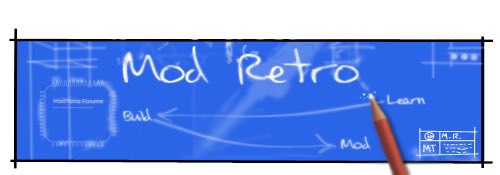After I saw Brunoip's printer, I really wanted to make something like that for myself. So I decided to make a plotter, heavily basing the design off Bruno's project.

It has a 1.5x1.5 inch printing area, or 120x120 pixels. Here's a quick WIP overview:
The casings of all the CD and floppy drives I went through:

Beginning stages of the carriage and pen holder. The gear assembly was the opening mechanism for a CD drive. The sliding assembly was made with bent N64 heatsink, floppy drive read head sliding assemblies, and plastic. (Though that part isn't shown here.) I bought some plastics epoxy for this project - it was a godsend.
Also, tip - if you're working with a soft material like plastic of aluminum, you can usually drill a hole and just use the screw to tap it. That's what I did for all the tapped holes in this project, and it works very well.

The motor assembly is held with a spring and a loose screw. This keeps it stable, but lets the assembly give a little when the pen hits the paper.

Had to buy $5 worth of hardware for the x and y axes. Total project cost: $5.

Prototyping the motor control circuitry. A MOSFET turns the motor on and off, and another controls a DPDT relay that reverses current to the motor. Because everything else ran off 5v and the relay was 12v, I grabbed a TI step-up regulator I had laying around for a long time and used that just for driving the relay.

Close up of the installed control board. The right-angle header on the right is for the pen motor, the big header here is for the parallel port, and the small header goes to the floppy drive boards.

Close up of the whole pen assembly. The switch detects when the pen holder has gone down far enough, and signals the computer to reverse the motor. You can also see the pen holder I detailed earlier.

And the tray to hold the paper. You can see one of the two metal clips used to keep it from moving:

Here's a few examples of how the prints turn out:
At 80dpi, it can make some pretty small stuff. I need a better pen for that, though, because ballpoints don't work so well when you just tap them on stuff, and the ultra-fine Sharpie is too big and bleeds everywhere. The lines turned out rather wavy on that mini Twilight for some reason, but it does the fine stuff very well usually.


This is one of my favorites, printed on the back of my school ID:

Obligatory Palmer. The spiral above him was printed with the "Ballpoint Mode" in my software, where it puts the pen down, moves it forward and back one step, then lifts it. It makes much darker points at the cost of some smudginess.

That's it! If you have any questions, please ask.

It has a 1.5x1.5 inch printing area, or 120x120 pixels. Here's a quick WIP overview:
The casings of all the CD and floppy drives I went through:

Beginning stages of the carriage and pen holder. The gear assembly was the opening mechanism for a CD drive. The sliding assembly was made with bent N64 heatsink, floppy drive read head sliding assemblies, and plastic. (Though that part isn't shown here.) I bought some plastics epoxy for this project - it was a godsend.
Also, tip - if you're working with a soft material like plastic of aluminum, you can usually drill a hole and just use the screw to tap it. That's what I did for all the tapped holes in this project, and it works very well.

The motor assembly is held with a spring and a loose screw. This keeps it stable, but lets the assembly give a little when the pen hits the paper.

Had to buy $5 worth of hardware for the x and y axes. Total project cost: $5.

Prototyping the motor control circuitry. A MOSFET turns the motor on and off, and another controls a DPDT relay that reverses current to the motor. Because everything else ran off 5v and the relay was 12v, I grabbed a TI step-up regulator I had laying around for a long time and used that just for driving the relay.

Close up of the installed control board. The right-angle header on the right is for the pen motor, the big header here is for the parallel port, and the small header goes to the floppy drive boards.

Close up of the whole pen assembly. The switch detects when the pen holder has gone down far enough, and signals the computer to reverse the motor. You can also see the pen holder I detailed earlier.

And the tray to hold the paper. You can see one of the two metal clips used to keep it from moving:

Here's a few examples of how the prints turn out:
At 80dpi, it can make some pretty small stuff. I need a better pen for that, though, because ballpoints don't work so well when you just tap them on stuff, and the ultra-fine Sharpie is too big and bleeds everywhere. The lines turned out rather wavy on that mini Twilight for some reason, but it does the fine stuff very well usually.


This is one of my favorites, printed on the back of my school ID:

Obligatory Palmer. The spiral above him was printed with the "Ballpoint Mode" in my software, where it puts the pen down, moves it forward and back one step, then lifts it. It makes much darker points at the cost of some smudginess.

That's it! If you have any questions, please ask.
